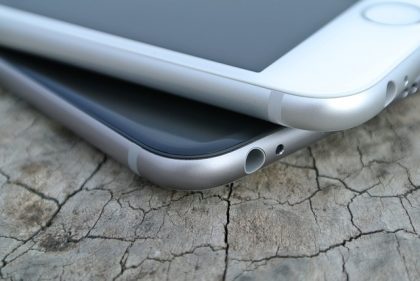
An overview of the main differences between the iPhone 8 Plus and the 6 Plus from 2014 and an idea of cost difference buying a new 8 Plus or a reconditioned 6.
How the bigger screened iPhone has moved on during the past three years
The launch of the iPhone 8 marks the fourth generation of Apple’s mega selling smartphone to feature a larger screened ‘phablet’ version. The option of a bigger, 5.5 inch screen Plus version of the iPhone started when the 6 Plus was launched in the autumn of 2014 alongside its smaller 4.7 inch screen brother.
The phone’s design hasn’t altered significantly although other aspects have since autumn 2014 when the 6 and 6 Plus were introduced.
The 6 Plus: an unexpected move for Apple
From the launch of the original iPhone back in 2007, Apple always maintained they’d keep their smartphone compact and ‘pocketable’ so it seemed unlikely a jumbo sized model would ever appear.
Therefore, the launch of the 6 caused ripples when the Plus appeared to give the iPhone a bigger screened version to directly compete with models such as the Samsung Galaxy that had sported larger screens for some while.
How has Apple’s game moved on?
It’s fair to say that not all new iPhones offer huge advances over their predecessors. This is true of the new 8 in that many tech commentators don’t feel it offers enough new features to warrant an upgrade from the 7, which in turn wasn’t considered much of a significant jump compared to the 6S it replaced.
Indeed, the 6 was arguably the most significant iPhone in recent years; along with introducing the bigger Plus version, it was the first to incorporate the body design of today’s iPhone and increase the screen size of the ‘standard’ model from 4 to 4.7 inches. If you like the idea of a larger screen, a refurbished iPhone 6 Plus would offer many of the key attributes the iPhone is known for and could run out at less than £300.
There again, if the newer tech appeals then the 8 Plus does contain some advances over the 6 albeit at a starting price of virtually £800.
Screen – the latest 8 Plus has an identical 5.5 screen to the 6 but offers True Tone technology similar to that used on Apple’s flagship tablet, the iPad Pro. This helps enhance the colours by adjusting the screen relative to the ambient lighting conditions.
Camera –an area where the 8 does move the game on although the main change was made when the 6 was replaced by the 6S in 2015.
The Plus sports a dual lens camera with one being a wide-angle and the other a telephoto lens. The imaging software has been improved and, more significantly, the sensor is larger so more light enters the camera thus improving imaging generally and being particularly beneficial for low light photography in reducing ‘noise.’
The megapixel count has gone up from 8 on the iPhone 6 to 12 on the latest model’s rear camera, and from 1.2 to 7 for the front one. Flash performance is improved and there are more adjustment options such as subject lighting effect adjustments including one that can make your subject appear as if professionally shot in a studio.
Body – although it looks the same and is virtually the same dimensions, the rear of the 8 is made of glass as opposed to aluminium.
Wireless charging – the 8 is the first iPhone to feature wireless battery charging and deploys the widely used Qi standard so is compatible with most public wireless charging facilities.
Fast charging – the 8’s battery can be charged to 50% inside half an hour. You’d need a special charging adaptor as the standard one supplied can’t fast charge the phone.
No headphone socket – since the iPhone 7, Apple has dispensed with the 3.5mm headphone socket. Although the company clearly believes people are increasingly using Bluetooth earbuds and headphones, an adaptor that connects to the lightning socket is included so wired earbuds can still be used.
Stereo loudspeakers – these have featured since the iPhone 7’s launch.
More power – just about every new iPhone features a more powerful processing chip, and from the A8 variant in the 6 there is now an A11 ‘Bionic’ powerhouse in the iPhone 8 Plus. This is often academic, however, in that many users never really get anywhere near the limits of modern processors – you may find the 6 perfectly quick enough for your needs.
Waterproofing – the 8 is waterproof to an official rating of IP67; this means it could withstand being immersed in 1 metre of water for half an hour.
Home button action – while the home button is still there on the 8, it works differently to that on the 6 and all iPhones prior to the 7. Instead of being physically pressed as before, it now senses when you put your finger on it and responds to pressure without actually depressing as with the older version.
3D Touch – a feature where the screen can detect the amount of pressure you exert on the screen. This feature is slightly academic as it will depend on apps being developed to make full use of it.
Enough to tempt you?
The above enhancements may or may not be enough to make you consider a new iPhone 8 Plus over a used 6 Plus such as a reconditioned model. While the above shows Apple have made some changes over the past three years, it does come at a considerable price.
![]()
